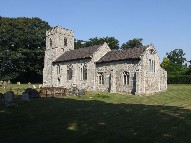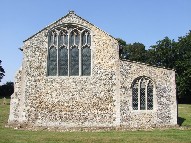| |
|
St
George, South Acre
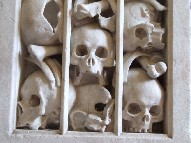 |
|
Here
we are in the winding lanes of west Norfolk, out
beyond the Swaffham to Fakenham road. Out here,
secret villages hide in folds of fields and
woods, and lanes peter out into nothingness. Of
course, it isn't all a secret. Castle Acre, for
example, is one of the best known and loved
villages in Norfolk. Its castle, priory and
church attract plenty of tourists, as do its pubs
and tat shops, but I wonder how many visitors
make it to this delightful little corner, about a
mile's walk from the high street? South Acre
is little more than a church and a few houses,
and the church is humble and homely in comparison
with the splendour and delights of the nearby
larger village. But inside this building is one
of the most atmospheric and fascinating interiors
in Norfolk, full of historical details and a
sense of the numinous. It is one of my favourite
small churches in England.
|
Externally,
the building is rather curious, its south and north sides
being completely different in character. The north face,
which it turns to the road, is organic and earthy, full
of 14th century grandeur. The south side is crisper and
of the character of the 15th century, although I suspect
this is mainly the result of 19th century restoration.
The entrance is from the north, and you step into a
perfectly rural and ancient space, with brick floors
spreading in all directions, and the rugged, primitive
Norman font topped by a 16th century Perpendicular canopy
which lifts the eyes to the beautiful hammerbeam roofs.
To the
east runs a homely, low arcade, dividing off the north
aisle. This aisle contains the most significant feature
of the church, the Barkham mausoleum of the early 17th
century, behind a contemporary wrought iron screen. Sir
Edward Barkham, who died in 1623, was a former Lord Mayor
of London, and the memorial he shares with his wife
Penelope is one of the most delightful in Norfolk. It was
made by the Christmas Brothers, and features Sir Edward
and Lady Penelope lying together, their heads facing
west. They are dressed elegantly in the clothes of the
day, but it is really the details of the tomb which catch
the eye: Life as a young girl, and death as a grinning,
shrouded skeleton, flank the inscription, while an hour
glass sprouts gilt wings. Below, two sons and three
daughters kneel in prayer, but they seem distracted, lost
in thought and peering around corners. Between them, a
charnel cage is filled with the skulls and bones of the
Barkham dead. The whole piece is utterly enchanting.
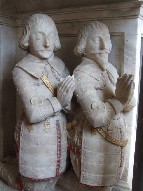 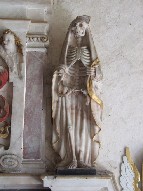 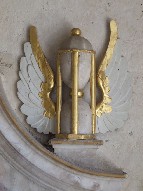 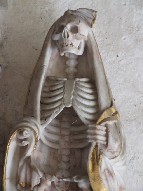 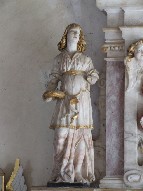
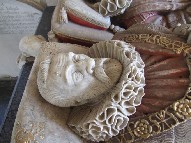 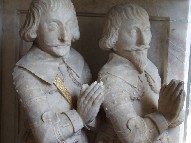 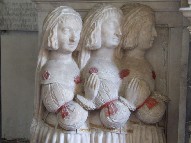 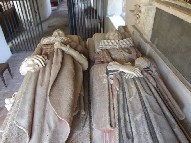
The
Barkhams rather steal the show here, but it is another
family, the Harsicks, whose name is found the most often.
At the west end of the Barkham memorial, within their
chapel, is a large brass to Sir John Harsick and his
wife. Harsick died in 1384, and the formal portrait of
the pair, almost life-size, is softened when you notice
with a frisson, in Larkin's words, his left-hand gauntlet, still clasped
empty in the other; and one sees, with a sharp tender
shock, his hand withdrawn, holding her hand. Then
the image becomes a perfect illustration for An
Arundel Tomb, proving our almost-instinct
almost-true, what will survive of us is love.
Another Harsick is probably the
stone effigy of a Knight Templar further west, Sir Eudo,
who is known to have taken part in the crusades. More
intriguing, and certainly more startling, is the eroded
wooden effigy, now in a tomb recess on the south side of
the chancel. On the floor nearby is another brass figure,
Thomas Leman, who was Rector here and died in 1534 -
assuming this inscription was made pretty soon after his
death, it had barely a decade to ask for prayers for his
soul before such things became illegal. Another brass
figure is in the nave, of a similar date. There is a
simple engraved brass of the Blessed Virgin and child, a
rare survival; I only recall seeing this twice elsewhere
in East Anglia. These, taken with the inscription on the
font cover which asks for prayers for the soul of
Geoffrey Baker in 1534 suggests that, in the last gasp of
Catholic England before the Reformation, a large amount
of money was spent here at South Acre.
| There
is a smattering of medieval glass in the north
aisle, and bench ends which are probably a
century earlier than the font cover. But even if
it was not for these, the utter charm of this
pretty interior would be enough of an enticement.
And little details that speak of the care of
centuries past; the stone memorial in the chancel
wall tells us that, in August 1725, the Reverend
Mr William Brocklebank new pavid this chancel
with stone at his own charge, had the gravestones
clean'd and laid even, removid none that had any
inscription, but gave three plain ones to be laid
in the body of the church. There are ledger
stones in the north aisle to an 18th century
Rector, George King, and his relict
Elizabeth, and pretty bench ends carved by an
early 20th century successor, including a snail,
a frog and a fish. It all builds to a harmonious
whole, the perfection of a gorgeous, rustic
little village church, the slowly beating heart
of its parish. |
|
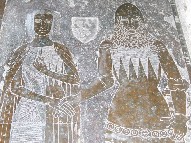 |
|
|
|

